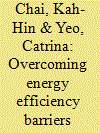|
|
|
Sort Order |
|
|
|
Items / Page
|
|
|
|
|
|
|
| Srl | Item |
| 1 |
ID:
112926


|
|
|
|
|
| Publication |
2012.
|
| Summary/Abstract |
In this paper we propose a framework which categorizes energy efficiency barriers based on the stage at which the barriers exist. Barriers to energy efficiency have been widely studied but to our knowledge, except for a few studies, we found inadequate consideration for barrier-barrier interactions when proposing policy measures for improving energy efficiency. Leveraging systems thinking's power as a problem solver which identifies underlying structure that explains (similar) patterns of behavior in a variety of different situations, we attempted to identify patterns of barriers to adoption of energy efficiency measures in industrial companies. Inspired by systems thinking, the proposed framework has four stages, namely, Motivation, Capability, Implementation and Results, as well as a feedback loop. Using a case study, we show that following the four stages will lead to positive feedback for future energy efficiency implementations. The framework highlights the interconnected nature of the barriers and a need for policymakers to address these barriers in a holistic manner. We argue that the overall effectiveness of energy efficiency policies is only as strong as the weakest link in the four-stage framework. This differs from most prior research that addressed barriers in isolation, where a solution is proposed for each of the barriers without considering the relationship between the barriers. Our framework also offers a way to understand the roles and responsibilities of major stakeholders such as governments and energy service companies (ESCOs) in driving energy efficiency. This allows the assessment and identification of weak links in energy efficiency policies.
|
|
|
|
|
|
|
|
|
|
|
|
|
|
|
|
| 2 |
ID:
183590


|
|
|
|
|
| Summary/Abstract |
Photovoltaic (PV) technology innovation is one of the important ways to achieve energy transition in China. To overcome market failures and institutional barriers, policy support is necessary for PV technology innovation. As regions are the main actors in the technology innovation process, more attention should be paid to regions when designing a PV policy. Therefore, this study assesses the effects of regional policies on PV technology innovation using a large panel data on 260 cities in China from 2007 to 2018. The empirical results show that city-level PV incentive policy instruments have a significant effect on PV technology innovation, but applying more PV policy instruments simultaneously is not always better. Moreover, city-level demand-, supply-, and environment-side policies play an important role in urban PV technology innovation, and a high balance among the three types of PV policy can make their innovation effect better. Finally, this study also finds that the effects of different city-level PV policy instruments on PV technology innovation are heterogeneous. Not only that, the effectiveness of these city-level PV policy instruments on PV technology innovation is also affected by urban heterogeneities.
|
|
|
|
|
|
|
|
|
|
|
|
|
|
|
|
|
|
|
|
|